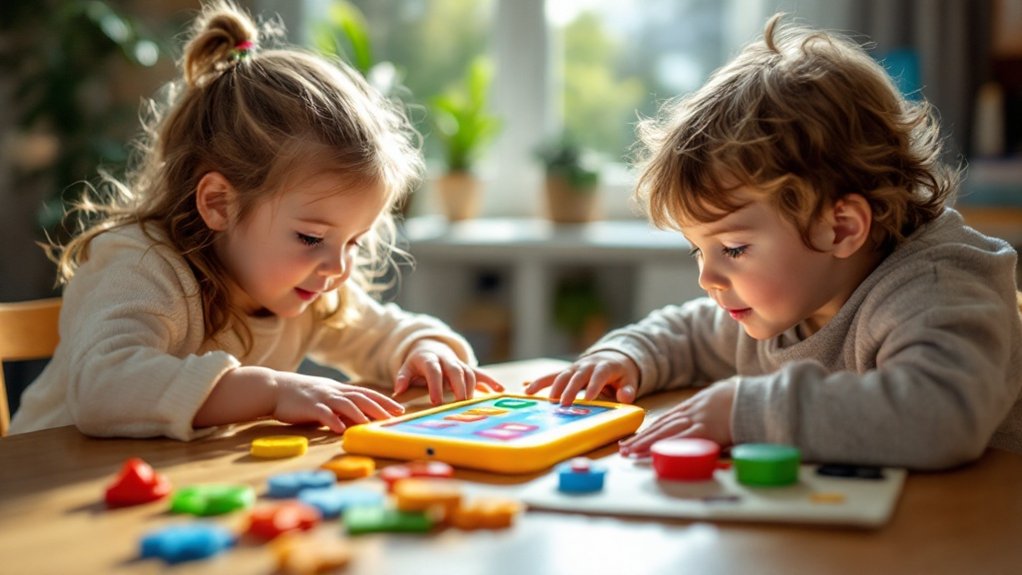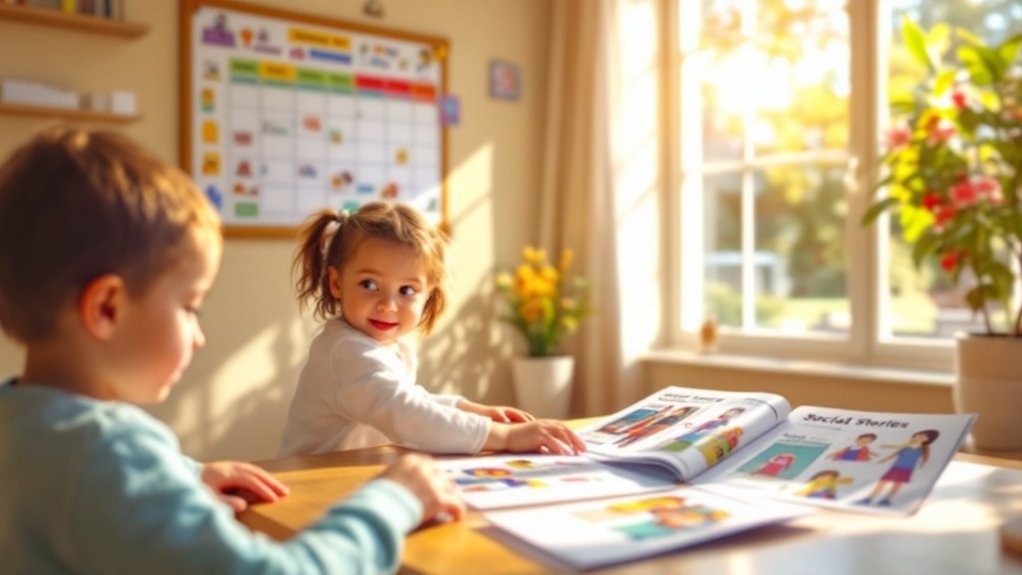Last Updated on December 15, 2025 by Lisa Whaley
Effective non-verbal autism communication strategies focus on empowering expression through diverse tools and methods.
Key approaches include Picture Exchange Communication System (PECS), AAC devices, sign language, visual schedules, gesture-based systems, assistive technology apps, sensory tools, environmental supports, and interactive play.
Each strategy can be customized to match individual needs and abilities, helping children build confidence and independence. Understanding these communication pathways opens doors to deeper connections and meaningful progress in development.
Key Takeaways
- Implement Picture Exchange Communication System (PECS) by using picture cards for expressing needs and wants through structured exchanges.
- Create visual schedules with clear sequential pictures to establish routines and reduce anxiety during daily activities.
- Utilize AAC devices and communication apps with customizable interfaces to enable digital expression through pictures and text-to-speech.
- Teach basic sign language and gestures for immediate expression of needs, starting with simple movements and expanding vocabulary gradually.
- Develop recognition of body language cues while using environmental supports like color-coding and labeled spaces to enhance understanding.
Picture Exchange Communication System (PECS)

The Picture Exchange Communication System (PECS) stands as a transformative tool in helping non-verbal autistic individuals develop functional communication skills. Through structured PECS training, children learn to exchange picture cards for desired items, gradually building their ability to communicate needs and wants effectively.
This visual communication approach follows a six-phase protocol, beginning with simple exchanges and progressing to more complex sentence structures. As learners advance, they’ll combine symbol cards to form requests, comments, and even express emotions.
The system’s strength lies in its systematic nature, allowing individuals to develop independence while reducing frustration associated with communication barriers.
Parents and educators who implement PECS often report significant improvements in their children’s social interactions and decreased behavioral challenges. The system’s portable nature means it can be used across various settings – from home to school – providing consistency and reliability in communication methods.
Augmentative and Alternative Communication (AAC) Devices

Building upon the visual foundations of PECS, modern Augmentative and Alternative Communication (AAC) devices expand communication possibilities through digital technology. AAC software options now range from basic symbol-based apps to sophisticated text-to-speech programs, making communication accessible for individuals with various disabilities.
AAC device features include customizable interfaces, predictive text, and voice output that can be personalized to match the user’s age and identity.
Successful AAC implementation strategies rely on extensive AAC training programs for both users and support networks. Parents and educators report inspiring AAC success stories when considering AAC accessibility considerations like motor skills, vision needs, and cognitive abilities.
AAC user experiences show that consistent practice, patient support, and the right device match can lead to breakthrough moments in expression and connection. Many children who struggled with traditional communication methods have found their voice through AAC, demonstrating these tools’ transformative potential in supporting autism communication development.
Sign Language and Manual Signs

While AAC devices offer technological solutions, sign language and manual signs present a natural, embodied approach to non-verbal communication that’s readily available without equipment. The sign language benefits for autistic individuals include immediate expression of needs, emotions, and thoughts through gestures that can be learned at their own pace.
Research has shown manual signs effectiveness in reducing frustration and improving social interaction, particularly when introduced early in a child’s development. Parents and caregivers can start with basic signs for everyday needs like “more,” “help,” “eat,” and “drink,” gradually expanding the vocabulary as the child progresses.
Many autistic individuals find hand movements easier to process and reproduce than verbal speech, making sign language an invaluable tool for building confidence and independence. When combined with other communication strategies, signing can create a robust foundation for lifelong communication skills, enabling meaningful connections with family members, teachers, and peers.
Visual Schedules and Social Stories

Visual schedules and social stories provide essential structure and understanding for non-verbal autistic children by breaking down daily activities into clear, sequential pictures or symbols that reduce anxiety and increase independence.
Social storytelling complements visual schedules by using simple narratives with supporting images to help children understand and prepare for various social situations, from doctor visits to classroom interactions.
These evidence-based tools empower parents and educators to create predictable routines while building vital communication bridges that help non-verbal autistic children better navigate their world and express their needs.
Creating Daily Visual Routines
Establishing clear daily routines through visual supports offers children with non-verbal autism a powerful way to understand, predict, and participate in their everyday activities. When creating visual schedules, it’s crucial to maintain daily routine consistency by using clear, recognizable images or symbols that represent specific tasks and activities.
Parents and caregivers can enhance visual schedule creation by photographing actual objects, environments, and people from the child’s life, making the routine more personally meaningful and easier to comprehend.
Breaking down complex activities into smaller, manageable steps helps children process information more effectively. These visual supports should be readily accessible throughout the day, displayed at the child’s eye level, and consistently referenced during changes.
Benefits of Social Storytelling
Since children with non-verbal autism often struggle to understand social situations and upcoming events, social storytelling through visual schedules and social stories provides an invaluable framework for reducing anxiety and building comprehension.
These social narrative techniques help break down complex interactions into digestible, visual sequences that make daily life more predictable and manageable.
Through emotional connection storytelling, children can better grasp abstract concepts like taking turns, following classroom rules, or handling changes in routine.
Social stories also give parents and caregivers a powerful tool to prepare children for new experiences, from doctor visits to family gatherings.
When combined with pictures, symbols, and simple text, these narratives create a bridge of understanding that empowers non-verbal children to navigate their world with greater confidence and reduced stress.
Gesture-Based Communication Systems

A well-structured gesture-based communication system can open new doors for children with non-verbal autism, creating pathways for expression that don’t rely on spoken words. Through carefully designed hand signals, body movements, and facial expressions, children can communicate their needs, feelings, and thoughts with remarkable clarity.
Modern gesture recognition technology has revolutionized this approach, offering interactive gesture games that make learning these systems engaging and rewarding. Children can practice their gestures with immediate feedback, building confidence as they master each new movement. The technology adapts to each child’s unique capabilities, ensuring a personalized learning experience.
When implementing gesture-based systems, it’s crucial to start with basic, natural movements that align with the child’s existing behavioral patterns. Simple gestures for “yes,” “no,” “more,” and “help” form the foundation, gradually expanding to more complex expressions as the child’s comfort and proficiency grow.
Eye Gaze and Body Language Interpretation

Interpreting eye gaze patterns and body language is essential for understanding non-verbal communication in children with autism, as these physical signals often reveal thoughts, needs, and emotions that can’t be expressed through speech.
Parents and caregivers can learn to recognize subtle facial expressions, such as raised eyebrows indicating interest or furrowed brows showing distress, along with body positioning cues like turning away to indicate overstimulation or leaning forward to show engagement.
Reading Facial Expressions
Understanding facial expressions and body language serves as an essential bridge between non-verbal autistic individuals and their communication partners. When working with autistic individuals, it’s important to recognize that their emotion recognition abilities may differ from neurotypical patterns, requiring patience and consistent support.
Teaching facial cues often involves breaking down expressions into smaller, manageable components that can be learned systematically. Visual supports, such as emotion cards or digital tools showing various expressions, help autistic individuals connect specific facial features with corresponding emotions.
Many find success using mirror exercises, where they practice recognizing and mimicking expressions alongside their communication partners. Remember that each person’s journey in developing these skills is unique, and progress should be celebrated at every step, no matter how small.
Body Positioning Signals
While non-verbal autistic individuals communicate in diverse ways, body positioning signals often serve as their primary means of expressing needs, desires, and emotions. Understanding these subtle cues requires caregivers to develop heightened awareness of spatial orientation and body positioning patterns.
When an autistic person turns their body away, they’re often communicating discomfort or overstimulation. Alternatively, leaning forward might indicate interest or a desire to engage.
Close attention to an individual’s body awareness can reveal patterns in how they establish boundaries, show affection, or express distress. Watch for repetitive movements, which may signal anxiety or excitement, and notice how they position themselves in relation to others.
Learning to interpret these physical indicators empowers caregivers to respond appropriately and support meaningful connections with their non-verbal loved ones.
Assistive Technology and Communication Apps
As technology continues to advance, assistive communication devices and apps have revolutionized the way non-verbal autistic individuals express themselves. Current assistive technology trends include touch-screen tablets equipped with sophisticated communication software, eye-tracking devices, and wearable tech that converts gestures into speech. These tools provide unprecedented opportunities for expression and connection.
Modern communication app features now offer customizable picture boards, text-to-speech capabilities, and predictive language options that adapt to each user’s unique needs. Apps can incorporate personal photos, favorite activities, and daily routines, making communication more natural and meaningful.
Many platforms also allow for different levels of complexity, growing with the individual as their communication skills develop.
For families supporting non-verbal autistic children, these technological solutions offer hope and practical support, enabling their loved ones to share thoughts, feelings, and needs with greater independence and confidence.
Sensory-Based Communication Tools

Sensory-based communication tools have transformed the way non-verbal autistic individuals express their needs and preferences through tactile, visual, and object-based systems that engage multiple senses.
Visual Picture Exchange Systems (PECS) and touch-based communication boards give children concrete ways to make choices and communicate desires by selecting, pointing to, or exchanging images and symbols that represent their thoughts.
Object-based choice making takes communication a step further by allowing children to physically handle and select real items that represent their wants or needs, creating a direct connection between the tangible world and their ability to express themselves.
Visual Picture Exchange Systems
Visual Picture Exchange Systems (PECS) represent a transformative breakthrough in helping non-verbal autistic individuals communicate their needs, wants, and thoughts through the strategic use of pictures, symbols, and images.
These visual communication techniques empower individuals to initiate meaningful interactions by selecting and exchanging picture cards that represent their desired items, activities, or feelings.
Through careful picture card customization, families and educators can create personalized communication sets that reflect each person’s unique interests, daily routines, and emotional experiences. The system gradually builds from simple requests to more complex sentence formations, fostering independence and reducing frustration.
As users become more proficient with PECS, they often develop increased confidence in their ability to express themselves, leading to improved social interactions and a greater sense of connection with their support network.
Touch-Based Communication Boards
Touch-based communication boards represent one of the most intuitive and physically engaging tools in the domain of alternative communication, enabling non-verbal autistic individuals to express themselves through tactile interaction.
These specialized boards feature raised tactile symbols and textures that users can explore with their fingertips, creating a multi-sensory experience that enhances understanding and expression.
Through methodical touch exploration, individuals can associate specific textures and patterns with meanings, emotions, or needs. The physical nature of these boards proves especially beneficial for those who process information better through tactile engagement.
While learning to use tactile symbols may require patience and consistent practice, the rewards are significant – many users develop stronger communication skills and experience reduced frustration in expressing their thoughts and needs.
This hands-on approach often creates a deeper connection between the communicator and their support system.
Object-Based Choice Making
A powerful and intuitive approach to alternative communication involves using familiar objects that children with non-verbal autism can physically hold, manipulate, and select to express their preferences and needs.
Through object selection, children can indicate their choice preferences by interacting with tangible symbols that represent activities, foods, or desires.
Creating organized choice boards with meaningful visual cues helps children understand their options while respecting their sensory preferences. For example, a child might choose between a real spoon to indicate hunger or a small toy car to express wanting to play.
This object interaction provides concrete visual prompts that reduce anxiety and confusion while empowering children to communicate effectively. The key is selecting objects that hold personal significance and are easily distinguishable, allowing for clear and confident expression of wants and needs.
Non-Verbal Cues and Environmental Supports

While non-verbal autistic individuals may face unique communication challenges, today’s environmental supports and non-verbal cues offer powerful ways to express thoughts, needs, and emotions. Body language, facial expressions, and gestures serve as natural bridges for non-verbal communication, while strategically arranged environments can facilitate smoother interactions and reduce anxiety.
Environmental cues, such as visual schedules, labeled storage areas, and clear physical boundaries, help create predictable spaces where non-verbal individuals can navigate with greater confidence. Color-coding systems, picture-based instructions, and dedicated quiet zones provide essential structure and support.
These environmental modifications work alongside traditional non-verbal communication methods like pointing, nodding, or using hand signals to convey meaning. When caregivers and educators understand these non-verbal indicators and maintain consistent environmental supports, they create an atmosphere where autistic individuals can more effectively express themselves and participate in daily activities.
Building Communication Through Play and Interaction

Interactive play serves as a foundational bridge for developing communication skills in non-verbal autistic children. Through carefully structured activities like role playing games and interactive storytelling, children can explore communication in a low-pressure, engaging environment that sparks their natural curiosity and creativity.
When caregivers participate in play-based communication, they’re creating valuable opportunities for children to practice turn-taking, joint attention, and social reciprocity.
Simple activities like building with blocks, playing with puppets, or engaging in sensory play can become powerful tools for developing non-verbal communication skills. These interactions help children understand the give-and-take nature of communication while building their confidence in expressing themselves.
Frequently Asked Questions
How Early Can Non-Verbal Autism Communication Strategies Be Effectively Introduced?
Early intervention for non-verbal communication strategies can begin as soon as communication milestones aren’t being met, typically around 12-18 months of age.
Research shows that introducing alternative communication methods during these formative years can notably improve a child’s ability to express needs and connect with others.
Parents shouldn’t wait for a formal diagnosis, as implementing supportive strategies early on can make a substantial difference in their child’s developmental journey.
What Role Do Siblings Play in Supporting Non-Verbal Communication Development?
How can a brother or sister become a powerful catalyst for communication growth?
Siblings naturally create opportunities for meaningful interactions through daily play, serving as communication partners and role models. They can engage in communication games that feel natural and fun, making learning more organic.
Through patient modeling and positive reinforcement, siblings help bridge communication gaps, often becoming experts at interpreting their non-verbal sibling’s unique expressions and developing their own special ways of connecting.
Can Non-Verbal Communication Strategies Be Combined With Verbal Speech Development?
Non-verbal communication strategies can effectively complement speech development through thoughtful gesture integration and speech enhancement techniques.
Children can learn to pair gestures with emerging verbal skills, creating a bridge between different forms of expression. This combined approach strengthens their overall communication abilities while reducing frustration.
Speech therapists often encourage families to maintain both communication pathways, as they’ve found that non-verbal strategies can actually support and accelerate verbal development.
How Do Cultural Differences Impact the Effectiveness of Non-Verbal Communication Methods?
How can we guarantee our non-verbal communication methods work across different cultures?
Cultural context greatly impacts gestures, facial expressions, and body language interpretations, creating potential communication barriers that caregivers must navigate carefully.
What’s considered respectful eye contact in one culture might be viewed as confrontational in another.
That’s why it’s crucial to adapt non-verbal strategies to align with a family’s cultural background while maintaining their therapeutic effectiveness and respecting cultural sensitivities.
What Are the Success Rates for Different Non-Verbal Communication Approaches?
Success rates for non-verbal communication approaches vary considerably among individuals, with Picture Exchange Communication System (PECS) showing 80-90% effectiveness in early intervention cases.
Sign language methods demonstrate 65-75% success rates, while high-tech AAC devices achieve 70-85% positive outcomes when implemented consistently.
It’s essential to highlight that personalized approaches, combining multiple methods and adapting to individual needs, typically yield the highest success rates of 85-95% in developing functional communication skills.
Final Thoughts
Like a bridge connecting two shores, non-verbal communication strategies create essential pathways for autistic children to express their thoughts, needs, and dreams.
With dedication, patience, and the right combination of tools, every non-verbal child can find their unique voice and connect meaningfully with the world around them.




















